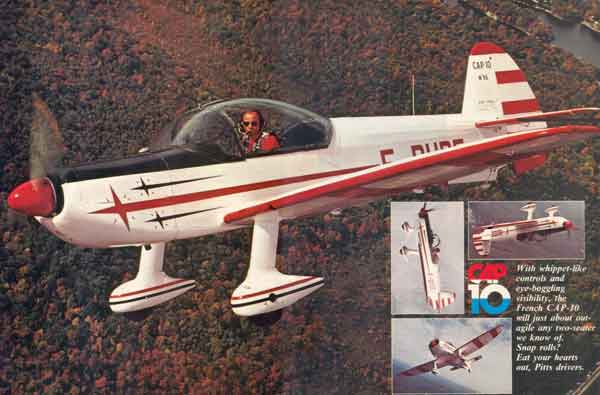
 |
CAP 10: A note about what follows: When I wrote this piece I'd had a Pitts about three years so was starting to get my feet wet in aerobatics. At the time serious aerobatics was in its infancy and we were all learning. In the course of doing this story, however, I first met Daniel Heligoin and Montaine Moullet, whom the world would soon know as The French Connection. They already knew what aerobatics was all about and became my good friends. When they died, the world lost two of its more interesting characters and most outstanding pilots. |
The little CAP 10 is definitely a "sleeper," a term the early street racing crowd used when referring to the motherly-looking Ford tudor grocery hacks that could blow your doors off with the big-inch Cadillac or Chrysler hemi they had shoehorned under the innocent-looking hood. That's the CAP 10. All charm and naivete. A lovely little two-seater with just enough individuality to set it apart from the Cessnas and Pipers. In the hands of a Sunday afternoon pattern pilot, the CAP 10 is a puddle jumper of the highest order... it seems custom-made for leisurely putting along over deserted beaches. But in the hands of an aerial Hot Rock, the CAP 10 can jerk your brains loose and scatter them around the cockpit as it rips from maneuver to maneuver in a style usually reserved for fast-sinking, big-motored, twitchy-handling biplanes. Yes, the CAP 10 is a true sleeper. Is the world really ready for a Cub-simple two-seater that cruises at 156 mph and can break the monotony of cross countries by doing Lomcevaks on cue? But then, if we waited until the world was ready for something different, we'd still be hunting fish with stone hammers. The CAP 10 is one of those very few airplanes that does many different things well, from primary training to cross countries to advanced competition style aerobatics. And then there's that other question: How can anybody hope to sell a French-built piece of aeronautical pastry that costs $29,900 in the states and only carries two people? (Ed Note from 2007: Is that funny or what?) Is there a marketing niche for such an intriguing little gadget? Logic says there almost has to be. Cessna is cranking out Acrobats like crazy and the Champ, now Citabria/Decathalon, is fetching something over $19,000 these days and Bellanca is selling all they can make. Curtiss Pitts hasn't stopped smiling since he started production of his two-place Pitts three years ago and the price tag on that piece of hot hardware is nudging $27,000. The CAP 10 does virtually everything the others do, more in most cases, and lets you do it all in comfort. After compressing your vertebrae at a contest, it'll bring you home without an acute case of "biplane butt," something we Pitts drivers would certainly appreciate. Now, don't get me wrong, I'm not putting down the homegrown domestic brands of akro birds. The Acrobat and Pitts have their place and appeal to a certain type of pilot. So does the CAP 10. It's tailor made for the guy who would like to do Pitts-quality aerobatics without having his mouth dry out on final every time he lands. The CAP 10 is made for the type of market that forced Ferrari to offer automatic transmissions and put recoil pads on Browning shotguns. By now you're probably wondering where this near-super plane came from: (Oh, you're not wondering? Well, I'm going to tell you anyway). The CAP is a product of Avions Mudry et Cie and C.A.A.R.P. in or around Bernay, France. C.A.A.R.P. are the initials of a bunch of French words that when boiled down say "Builders of Groovy Airplanes, Unlimited" (Ed Note: There’s THAT word again. I was sooo cool, or so I thought) or something like that. It consists of a group of craftsmen that build airplanes the way Frenchmen have always built airplanes... of wood. Without getting into the nitpicking history of a herd of chisel-wielding elfs who make aerial works of art, let it be understood that when it comes to wood, they know what they're doing.
If you've hung around the homebuilt crowd much or have visited a few French aero clubs, you've probably seen the forerunner of the CAP 10 and CAP-20 (single-seat advanced competition version). It is the Piel Emeraude (pronounced "Emeraude"). Both homebuilt and factory versions of the airplane have been built, but almost all of them in this country are of the backyard hand-rolled variety. However, lest you confuse the CAP and the Emeraude and start trying to do outside square octerflugerons in an Emeraude, you'd better know that the similarity between the two airplanes is strictly cosmetic. When the engineers started work on the CAP 10, they designed and built an entirely new and better airframe. The French, and Europeans in general, seem to view aerobatics as a natural and important part of a pilot's upbringing, so most of their training aircraft are acrobatic, and to a Frenchman, "acrobatic" means "inverted". None of this loop-roll-and-spin baloney. They start their acrobatic students out from lesson one with inverted flight. Try that in an Acrobat (no, don't!). When they designed the CAP 10, they automatically stressed and analyzed with outside maneuvers in mind. |
||